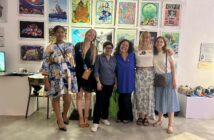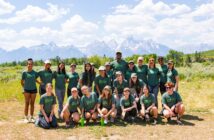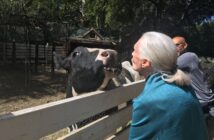At JGI, we’ve been using Jane’s approach to center the needs of human communities in our conservation efforts for decades. Dr. Lilian Pintea, vp of conservation science at JGI, has helped shape this work through the innovative use of science and technology, providing new pathways for powerful impact. Community-driven conservation is complex and requires commitment and partnerships, from local communities to scientists and policymakers to get it right and achieve positive change. It is through these efforts and lens that threats like deforestation are met with solutions that are more profound than just planting trees, and instead provide tools to ensure healthy forests and habits for animals, people, and their environments.
Building on this community-led approach, known as Tacare, conservation action planning enables scientists, local government officials, and other stakeholders to have a dialogue and collaborate, informed by science along with local knowledge and expertise. This conservation planning approach evolved into the Open Standards for the Practice of Conservation ( learn more about the Conservation Measures Partnerships) and it is an important tool as part of our Tacare toolbox. This helps to connect the needs of local communities with ecosystem services to support nature-based development.
Watch this video by Dr. Pintea on this essential approach and how it has evolved and continues to grow in remarkable and exciting ways.
FULL TEXT:
Hello everyone. I am Lilian Pintea, Vice President of Conservation Science for the Jane Goodall Institute USA. How do you connect planting trees with stopping deforestation and assuring healthy forests and habits for animals, people, and the environment? The linkages are more complex than you might think, and it takes commitment and partnerships, from local communities to scientists and policymakers to get it right and achieve positive change.
In 1994 our local team in Tanzania went to the villages around Gombe National Park in the larger Greater Gombe Ecosystem and engaged in a process of active listening, planning and action that now we call Tacare, our community driven approach to conservation. One of the first initiatives requested and supported by then Tacare project was planting trees to address the rapid increase in deforestation on the village lands outside Gombe National Park. By 2004 Tacare tree planting efforts spread to 14 villages outside Gombe.
However, something was not right. Despite of Tacare efforts, the deforestation rate in areas important to chimpanzees has still doubled, from 87.5 ha/year from 1972 through 1991 to 171 ha/year from 1991 through 2003. Therefore in 2005 we partnered with the Nature Conservancy to adopt in our work in Tanzania a systematic conservation action planning approach widely used by TNC in North America and other regions and to help connect community livelihood efforts with conservation objectives.
Building on Tacare success and partnership with the local communities, conservation planning process enabled scientists, local government officials, and other stakeholders to have a dialogue and collaborate, all informed by science and local knowledge and expertise. After all the planning work was done, we had an insight threat tables.
You see, tree planting was intended to provide local people as an alternative source of timber for boat construction and household consumption. However, the planning process and satellite imagery and mapping revealed that the main threat to forests outside Gombe was farming. Most of the forests and woodlands were converted to agriculture use. Therefore, while tree planting and nurseries were still important to support people’s livelihoods and need for timber, additional strategies were needed to address deforestation.
Equipped with this new knowledge, and guided by a spatial conservation plan, JGI Tanzania team adapted. It started to facilitate land use planning with village and district governments and to build local capacity, such as the use of smartphones by village forest monitors, to enforce their village land forest reserves. Only then we started to see positive change in the landscape, like these woodlands naturally regenerating between 2005 and 2020 as seen from Maxar satellite images.
Today the conservation planning approach evolved into the Open Standards for the Practice of Conservation and it is an important tool as part of our Tacare toolbox helping to connect the needs of local communities with ecosystem services to support nature-based development. It is also at the core of our Africa Programs and JGI strategy, creating meaningful partnerships across the chimpanzee range, creating windows of opportunities to influence real, on the ground conservation decisions, from Tanzania, to eastern DRC, western Republic of Congo and now to the entre chimpanzee range in west Africa with partners like Arcus, IUCN Section on Great Apes, TNC, Esri and many others.
And reaching to other organizations through networks such as Conservation Measure Partnership. This opens new possibilities how we could work together, how we could collaborate to scale our joint impact, and how we can transform a powerful action, like planting a tree, into a healthy forest for animals, people, and the environment.
I want to thank all our partners and you for your support and welcome to join us to make it happen.
You can support JGI’s community-led conservation work at janegoodall.org/donate.

The Jane Goodall Institute is a global community conservation organization that advances the vision and work of Dr. Jane Goodall. By protecting chimpanzees and inspiring people to conserve the natural world we all share, we improve the lives of people, animals and the environment. Everything is connected—everyone can make a difference.









